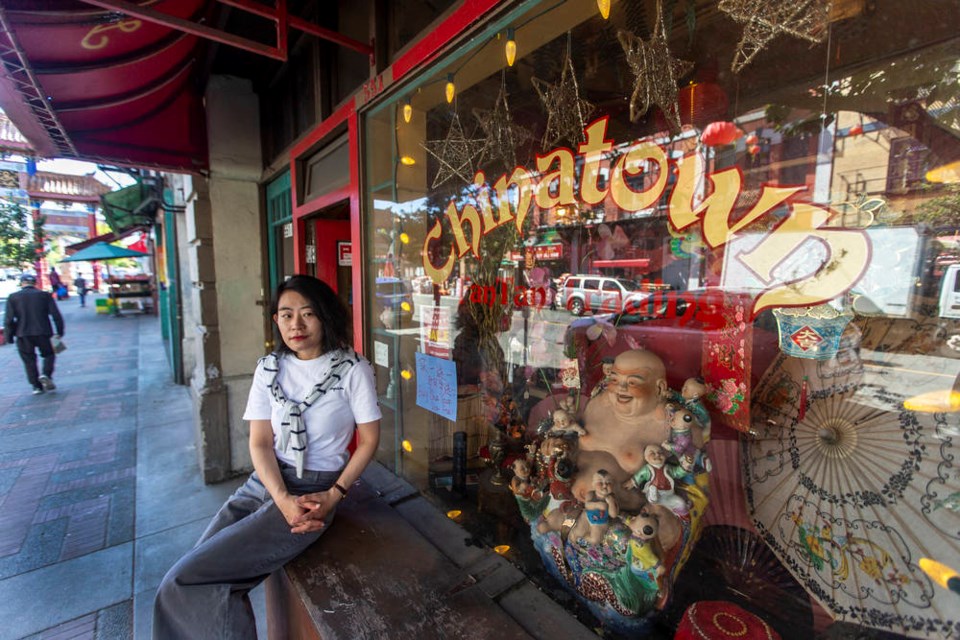Chinatown Fan Tan Trading is where everyone in Victoria would go when out-of-town company visited.
It was like something out of Harry Potter, a never-ending maze of cramped chaos and colour. Tea whisks, kites and lanterns fought for space with antique candle snuffers. Rosewood turtles nestled beside $5.99 sunglasses and vintage Asian porcelain, all of it crammed on the banks of a narrow retail river that meandered room by room from Fisgard Street to Fan Tan Alley.
Except the river was dammed four years ago when the building was cut in two, ending access to the Fan Tan Alley end.
And now the emporium will disappear altogether if a new owner can’t be found. And that will once again raise the question of where Chinatown is heading.
Fan Tan Trading’s current owner is Grathy Li, who bought the store three years ago when emigrating from northern China. Turns out she got some bad advice, and has fallen prey to an immigration rule that required her to be employed, but not self-employed, to stay in Canada. Long story short, she is moving to school in New Brunswick to satisfy the authorities.
The business has been a tough go, anyway. Its core customers are tourists, absent during COVID. Schoolkids still show up, looking for the real-life setting of Julie Lawson’s book White Jade Tiger, but people complain that the shop isn’t the same now that they can’t wander all the way out the back. Li has been closing the store on Wednesdays and Sundays, and only opening it from 11 a.m. to 2 p.m. on other days. If a new owner can’t be found, it will shut at the end of July.
“I feel so sad because it’s going to close down in my hands,” Li says.
She feels the weight of what the business, with its links to China, means to the community. “I really want Chinatown to be a real Chinatown.”
OK, but what does that mean? What should Chinatown be? A slice of the 19th century, preserved in amber? Tourism magnet? The centrepiece of a hip, vibrant but not terribly Chinese neighbourhood?
“Chinatown is very fragile right now,” says former Victoria mayor Alan Lowe, now part of an effort to bring a Chinese-Canadian museum to the area. The oldtimers are fading away, as are some institutions. The Yee Shan Association closed last year. The pandemic means the sound of mahjong tiles no longer drifts out of upper-storey windows.
It might be Canada’s oldest intact Chinatown — it was designated a national historic site in 1995 — but it has shrunk from half a dozen blocks to, roughly, one. The visibly Chinese presence is limited largely to the top half of Fisgard between Government and Store streets.
Chinatown has strengths, though. It still has landmarks like the Loy Sing butcher shop, thought to be the longest continually operating business of any Chinatown in North America. The Salient Group, founded by Robert Fung, described as an urban visionary for his work in Vancouver, has invested in a couple of buildings. “He wants to protect and keep the authenticity of Chinatown,” Lowe says.
Other buildings are family-owned or held by organizations with their roots in Chinese clans or districts. The future can be determined by what they do. Lowe was involved when the Hoy Sun Ning Yung building at the Pandora end of Fan Tan Alley was upgraded a few years ago, resulting in 32 housing units and seven retail spaces. “That building was falling down.”
People forget that a generation or two ago, the area was in decline. Then the Gate of Harmonious Interest was built, sidewalk brickwork went in, lanterns were added to lampposts and the city came up with a terrific program that offers property-tax breaks when heritage buildings are preserved and rejuvenated.
That kept the wrecking ball at bay. “What we have here are the buildings,” Lowe says. Now the challenge is to protect the stories behind them.
Those stories go back to a time when Chinese people were shunned elsewhere, one reason they congregated around Fisgard, says Victoria Coun. Charlayne Thornton-Joe. And then there were those businesses that, as much as they gave Chinatown its flavour, were a grind to those who worked in them 10 to 12 hours a day, seven days a week.
Thornton-Joe remembers her dad balking when, as a young woman, she told him she wanted to live in Chinatown. “They wanted us to get jobs that would give us a better life than they had.” From that perspective the flow away from Chinatown, with the vacuum often filled by what feels more like Gastown, reflects the immigrant dream.
At the same time, maintaining Chinatown’s authenticity is what attracts the additions that make the area vibrant. “We can have some stepping back into the past,” Thornton-Joe says, “and we can have some stepping into the future.”
•••
Gremlins struck on Thursday, when the last several paragraphs of my column on single-use plastics went missing from the print edition of the newspaper. Some would say this was an improvement. For those who want to read the rest, the full column can be found at timescolonist.com/more.



